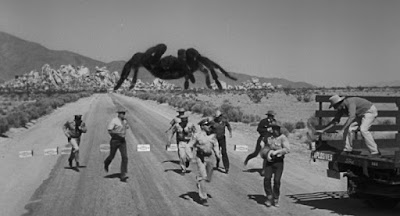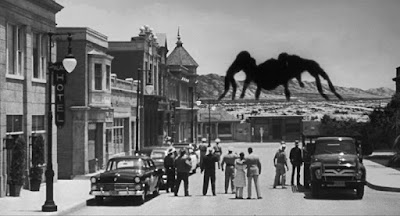(1955) Directed by Jack Arnold; Written by Robert M. Fresco and Martin Berkeley; Story by Jack Arnold and Robert M. Fresco; Starring: John Agar, Mara Corday, Leo G. Carroll, Nestor Paiva and Ross Elliott; Available on Blu-ray and DVD
Rating: ***½
Dr. Matt Hastings (John Agar): “But what if circumstances
magnified one of them in size and strength, took it out of its primitive world
and turned it loose in ours?”
Professor Townsend (Raymond Bailey): “Then expect something that's fiercer, more cruel and deadly than anything that ever walked the earth.”
What is it about the Arizona desert* that makes it the ideal setting for a bug movie? Phase IV (1974) and Kingdom of the Spiders (1977) are two notable examples that exploited the arid, unforgiving climate. As these films, and today’s featured title, would have you believe, the vast desert landscape is the perfect place to conceal something terrible under our very noses. Universal International’s** fourth collaboration between producer William Alland and director Jack Arnold (after It Came from Outer Space, Creature from the Black Lagoon, and Revenge of the Creature) was based on co-writer Robert M. Fresco’s*** original script for Science Fiction Theater episode, “No Food for Thought.” The most significant tweak to the original story was to add a giant spider. Produced on a modest $334,000 budget, Tarantula utilized real footage of a live spider, in lieu of stop-motion animation or puppetry, (with the exception of a mock-up of the big creature’s face, used for close-ups).
* Fun Fact #1: Tarantula was actually filmed in the California desert, in the town of Apple Valley, where the cast and crew had to contend with temperatures reaching 120 degrees (Fahrenheit). One scene features a prominent geological formation called Deadman’s Point, which was duplicated in miniature for a rockslide.
** Fun Fact #2: According to David Schecter, while the music is commonly attributed to Herman Stein and Henry Mancini, much of the score in the film was a hodge-podge of various snippets from the voluminous Universal library. Among the components “borrowed” from other films were cues from This Island Earth (1955) and It Came from Outer Space (1953).
*** Fun Fact #3: According to an interview with film historian Tom Weaver, Fresco claimed that he was forced to give Arnold co-credit for the story, although Arnold supposedly didn’t write any of it.
Genre movie stalwart John Agar stars as small-town family physician, Dr. Matt Hastings, who suspects something’s rotten in the state of Arizona. He’s called in by the local sheriff to examine the body of Eric Jacobs, a man who collapsed in the desert. The corpse’s distorted features indicate acromegaly (erroneously referred to as “acromegalia” in the film), which usually develops over years instead of days. Signs point to the esteemed Professor Gerald Deemer (Leo G. Carroll), who employed Jacobs in his home-based laboratory.*/** Deemer is tinkering with a hormone, which accelerates aging and results in rapid growth. Although he views his research as a possible solution to world hunger, it’s not so good for Jacobs, or a second lab assistant, Bob Lund,*** both who succumbed to the serum’s deleterious side effects. Lund blames Deemer for his disfigurement, attacking the scientist and throwing the lab equipment into disarray. In the ensuing scuffle, Lund smashes the glass to an enclosure for one of the test subjects, an enlarged tarantula, enabling the critter to escape.**** As a final insult, Lund injects the professor with a dose of his own medicine, ensuring that he’ll meet the same awful fate.
* Fun Fact #5: Professor Deemers’ home was the “Dabney
House,” on Universal’s backlot, built for the 1948 film Tap Roots. It
was also featured, with different backdrops, in genre favorites This Island Earth
(1955) and The Creature Walks Among Us (1956).
** While we’re on the subject of Professor Deemers, what’s the deal about scientists with home labs? As countless movies would lead you to believe, every scientist worth his or her salt is independently wealthy, with their place of research conveniently situated within their own home. Naturally, it’s all the better to carry out ethically dubious skullduggery on the sly, free from reliance on grants or the prying eyes of pesky university/government officials.
*** Fun Fact #4: If you feel a sense of déjà vu while watching this movie, your perceptions aren’t entirely unfounded. Stuntman Eddie Parker appears three times in the film, as Deemers’ lab partner Eric Jacobs, the sole ground crew who meets Dr. Hastings’ plane, and Paul Lund, his second lab assistant.
**** The mind reels, wondering what would have happened if one of the other lab animals had made their way out instead, such as an oversized guinea pig (nope, they didn’t use a capybara). I’m sure I speak for others when I state that Attack of the Giant Guinea Pig is something I would like to have seen.
As with most super-sized creature movies, a healthy suspension
of disbelief is required. In the real world, spiders (and other arthropods) are
limited in size due to several factors. Chiefly, the gargantuan tarantula
depicted in the film* wouldn’t be able to absorb enough oxygen with its current
breathing apparatus, and its exoskeleton would be too heavy and unwieldly. And
speaking of exoskeletons, considering the spider’s rapid growth, you’d think
there would be several molts lying around. In another bit of artistic license,
the tarantula roars, but we’ll let this slide.
* Fun Fact #6: According to Weaver, five tarantulas were cast for the role of the titular creature, although the film’s pressbook apparently claimed a much larger number were used.
Tarantula stays a cut above many of its giant bug contemporaries,
because it never forgets that while we’re obviously here for the spider, the human
characters* count. Director Arnold and crew takes a moment to get to know the characters
as three-dimensional people, not simply props for exposition or a means to move
the plot along. Hastings is an affable individual, as friendly as he’s inquisitive.
Carroll lends a touch of class to the production, as a man deeply invested in
his work. Stephanie “Steve” Clayton (Mara Corday), is pursuing her master’s degree
in biology, and knows her stuff but has her work cut out for her, navigating
the male-dominated academic and professional landscape depicted in the film. Character
actor Nestor Paiva provides a welcome face, and adds some subtle humor to the film,
as local sheriff, Jack Andrews. Hank Patterson also provides some levity as Josh,
the hotel manager/resident busybody. The movie keeps things interesting, thanks
to some snappy dialogue. When the dubious sheriff dismisses Hastings’
professional opinion over elder scientist Deemers, Hastings replies, “There’s
nothing like the safety of prestige.”
* Fun Fact: Watch for a young Clint Eastwood, in a small role, as a jet fighter pilot. You almost expect him to ask the giant spider if it feels lucky (spoiler: He doesn’t, and it’s not).
It wouldn’t be 1950s sci-fi without some unfortunate old-fashioned
misogyny, lobbed against Steve. When Hastings learns about her professional
aspirations the doctor comments, “Give women the vote and what do you get? Lady
scientists.” When she finally meets Deemers, her new employer, the professor states
that he didn’t expect his new assistant to look like her (not exactly a great
beginning to their professional relationship). Even the big spider is part of
the boys’ club. In a scene reminiscent of King Kong, the pervy arachnid sneaks
a peek into Steve’s bedroom window while she’s in her jammies, just before it
demolishes the house.
Compared to the titular monster in Jack Arnold’s earlier
movie, Creature from the Black Lagoon, the giant arachnid doesn’t have
much personality, mindlessly roaming the desert and consuming everything in its
path. Unlike King Kong, I don’t suspect many folks would shed a tear for
the errant arachnid. What makes the film tower above much of the competition is
its three-dimensional characters, dialogue and heart, keeping this from being a
by-the-numbers exercise. Perhaps just a shade behind Gojira (1954) and Them!
(1954), Tarantula remains one of the best giant critter movies of the ‘50s,
or any decade.
Sources for this article: DVD commentary by Tom Weaver, Dr. Robert J Kiss, and David Schecter; Science World article, “Why Aren’t SpidersBigger?”








Great review, Barry!
ReplyDeleteI have seen tarantula but did not know a lot of the behind-the-scenes stuff. Thankfully, I knew about Clint Eastwood when I saw it.
And yes, I would love to see attack of the giant guinea pig! 👍
Thanks, John! Hmm... Someone needs to get on that guinea pig movie, ASAP! ;)
Delete